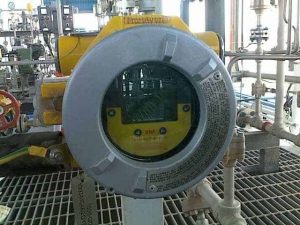How Toxic Gas Detectors work?
Learn how toxic gas monitors work in this free Abhisam White paper.

Introduction to Toxic Gas Detection
Industrial plants that manufacture chemicals, fertilizers, petroleum products, or, facilities that produce oil & gas, have to handle various toxic chemicals in their day to day operations. Many of these toxic chemicals are in the form of gases or vapors. This free Abhisam whitepaper will give a brief overview of the various kinds of toxic gas monitors used to detect these poisonous materials.
The example used will be a detector used to detect Hydrogen Sulfide gas, which is extremely toxic. These detectors are also called simply as H2S detectors in industry.
Why are toxic gas detectors used?
Toxic Gas detectors are mainly used for monitoring the presence harmful gases and vapors. These detectors are also referred to by many people as toxic gas monitors; both terms are interchangeable and mean the same.
These gas monitors enable a worker present in the plants that have these toxic gases, to protect himself from exposure. One of these ( commonly found harmful chemicals) is Hydrogen Sulfide. This gas that smells like rotten eggs, is even in low concentrations, extremely toxic. At lower levels of concentration the human nose can sense this as a “bad smell”, however, paradoxically at higher level, there is no sense of any smell, as the human nose gets desensitized. So a worker who accidentally walks into a Hydrogen Sulfide atmosphere can get literally knocked down, without finding anything amiss! Hence, it is critical that good, working, toxic gas detectors be used in such places to protect workers from accidental exposure.
For example, consider a process vessel in a chemical processing plant that normally contains Hydrogen sulfide gas. In normal operations this vessel will be tightly sealed and no Hydrogen Sulfide can escape. However, in case the vessel sealing does not work (for example, a flange on one of the inlet pipes leaks), then, it is likely that this Hydrogen Sulfide gas can leak out and harm the workers who operate the vessel or are in the nearby area.
To prevent this from happening, a toxic gas detector that can measure Hydrogen Sulfide gas, even in small concentrations, is mounted near the vessel. Whenever it detects a dangerous level of Hydrogen Sulfide, it will give out a warning alarm.
Note: For more information on toxic gas monitors and how they work, please take the Abhisam Gas Monitors online training course.

Types of toxic gas detectors
There are various technologies that are used to make toxic gas detectors. Also these instruments are available in various forms, like fixed, portable or pocket types. There are different sensors used to detect different types of toxic gases. Some types of sensors can detect a variety of different gases, others can detect only one type of gas.
Fixed toxic gas detectors
These are very commonly found in large manufacturing plants and similar facilities. Each fixed gas detector is mounted at a place where it is very likely to sense the toxic gas, in case of a leak. The detector may or may not have a local display that shows the concentration of the gas. Each detector is connected via cables to a central system, that is monitored by plant personnel. In case of a leak this panel will generate alarms to warn the operators about the dangers and may also carry out any interlock actions (like triggering closure of valves or initiating a shutdown).
Portable toxic gas detectors
Portable gas monitors are used by workers to sweep a work area, to know if there is any toxic gas lurking around the area. These detectors are also called as handheld gas detectors. These detectors are normally battery powered and have a display with a buzzer and lights, to warn the operator, in case a dangerous level of toxic gas is detected. They may have their own inbuilt sampling pumps, to draw air into the sensor. Some variants also store data, to calculate time weighted average values, peak values and other important data for regulatory compliance.

Pocket toxic gas detectors
A typical personal toxic gas monitor is shown in the picture here. These are similar to the portable gas monitor types, except that they are very small and meant to be carried by individual workers, by use of a belt clip, or inside a pocket. These instruments are normally throw away types and have a lifetime of about two years (lesser if they are constantly exposed to the toxic gas being detected). They also have a display, buzzer and light, but due to the small size there are no sampling pumps or data logging chips inside. Typically, a worker carries it with him, when he enters an area that could contain such a gas (for example, he will carry a pocket H2S detector when he enters a process vessel for cleaning, if it had processed Hydrogen Sulfide previously). The vessel might still have some amount of gas inside (or the gas may enter later through some piping that still remains connected). The worker’s pocket gas detector now acts like his guardian angel, or personal bodyguard and warns him immediately, should the gas be detected. This allows him to escape or be rescued by his co-workers.
Where to get more information?
You can get a very useful e-learning course on toxic gas detectors from Abhisam. This training course on gas monitors covers all types of gas detectors and gas monitors, including toxic gas monitors. If you take the online test (optional, free of cost), you can also get a certificate of achievement, that would be a useful testimonial.
Free Gas Monitor Information | White Paper
In this free Abhisam whitepaper find out how you can use Gas Monitors to manage hazardous areas effectively. Click here to know more.
Contact Us by filling the form below OR call us OR email

